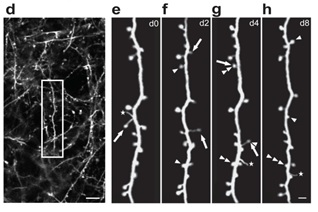
One fundamental question in neuroscience is how the brain processes and stores information. As the information-processing elements in the brain, neurons communicate via specialized connections called synapses. The majority of excitatory synapses reside at dendritic spines, which thus serve as a good proxy for synaptic connectivity.

Figure. Transcranial two-photon imaging of cortical neurons from the YFP-H line to study dynamics of dendritic spines over time. a, A subset of layer 5 pyramidal cells express YFP and extend their apical dendrites to layer 1. b, Principle of two-photon microscopy. c, A CCD camera image of the vasculature underneath the thinned skull.
Using transcranial two-photon microscopy to visualize fluorescently-labeled neurons in the brain of transgenic mice (YFP-H line) (see Figure), our recent studies followed the dynamics of spines on apical dendrites of L5 pyramidal neurons in the motor cortex during different forelimb specific motor learning. ?We found that novel tasks lead to rapid emergence of new spines on dendrites of pyramidal neurons in the motor cortex. Subsequent training of the same task preferentially stabilizes these learning-induced spines, which persist long after training terminates and thus may provide a structural basis for durable motor memory. Furthermore, spines that emerge during repetitions of the same motor task tend to cluster along dendrites, whereas spines formed during

Fiigure: ?d, A low-magnification 2D projection from a three-dimensional stack of dendritic branches and axons in the motor cortex of a WT mouse. A higher magnification view of the dendritic segment in the white box is shown in panel e. e-h, Four sequential images of the same dendritic branch obtained on day 0, 2, 4 and 8, revealing spine elimination (arrows), spine tandem execution of different motor tasks does not cluster. This suggests that the spatial distribution of synapses is actively regulated in vivo, and may encode memory traces for motor tasks. These studies have established a research platform to follow synapse reorganization during learning over time in living mice, which enable further investigations into motor learning and memory.
Reference:
1. ?Xu T, Yu X, Perlik A, Tobin W, Zweig J, Tennant K, Theresa J, and Zuo Y (2009) Rapid formation and selective stabilization of synapses for enduring motor memories. Nature 462(7275):915-919
2. ?Fu M, Yu X, Lu J and Zuo Y (2012) Learning induces clustered dendritic spine formation in vivo. Nature 483(7387):82-95
